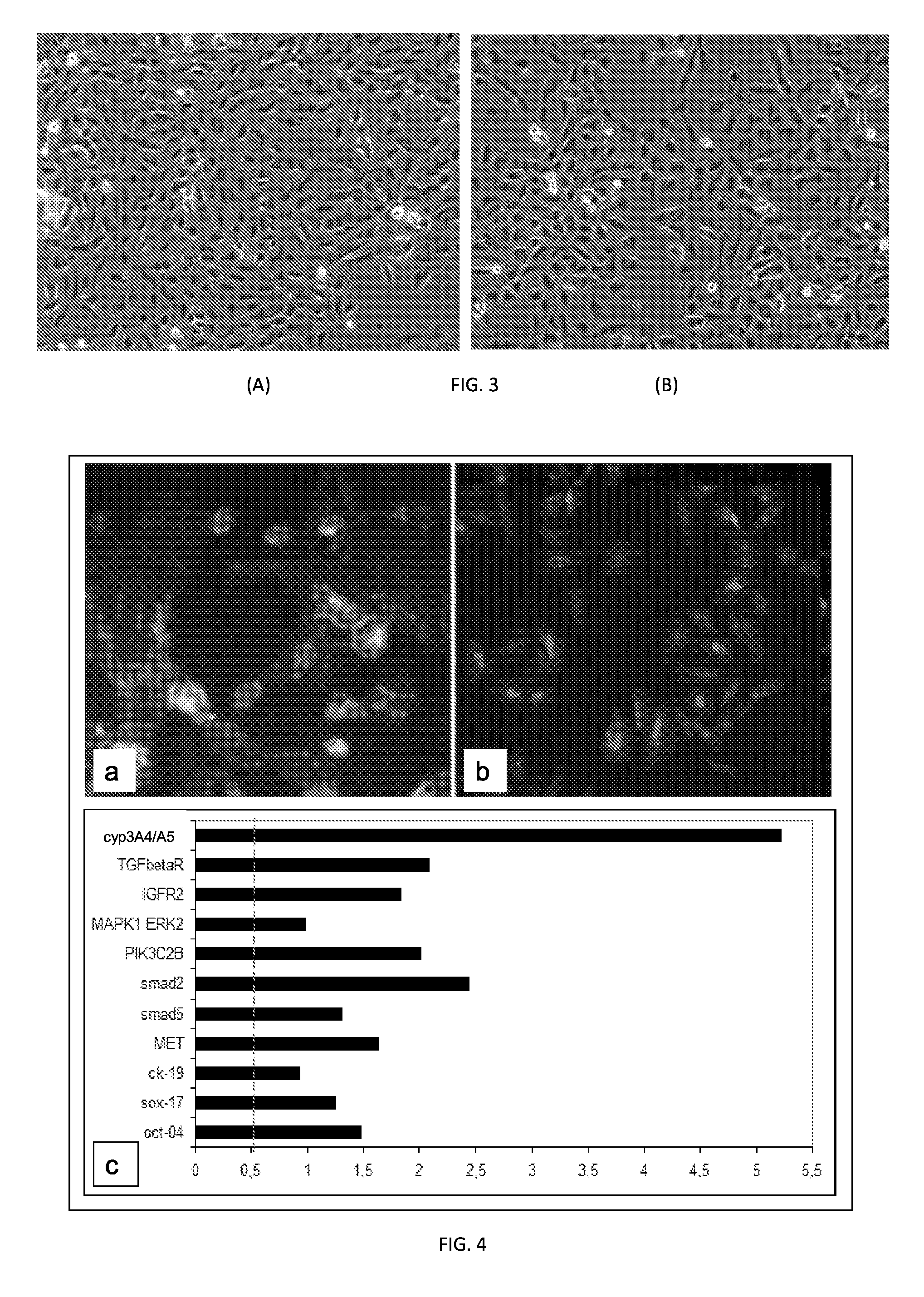Hepatic cell lines and stem-like cells, methods of making and using the same
a technology of stem-like cells and hepatic cells, applied in the field of reprogrammed cells and stem-like cells of hepatic cells, can solve the problems of limited cell plasticity, lack of cell bank availability, and progressive loss of many hepatic functions, and achieves stable karyotype, good cell plasticity, and characteristic morphology
- Summary
- Abstract
- Description
- Claims
- Application Information
AI Technical Summary
Benefits of technology
Problems solved by technology
Method used
Image
Examples
example 1
Methods for Producing Stem-Like Cells Such as Hepa-SC
[0070]The new method for reprogramming and producing stem-like cells involves subjecting cells with transdifferentiation properties in vivo and / or in vitro such as HEPARG® cells to predefined conditions, so that they start to lose their differentiation status.
A. The General Process for Inducing “Stemness”:
[0071]Step 1: Culturing the parental cells in a culture medium that has been modified in order to eliminate all factors supporting differentiation processes during a 2-passage culture period;[0072]Step 2: Inducing mechanical stress such as shape constraint, onto the cells in order to generate a reprogramming signal toward stemness that should be associated with occurrence of a mechano-transduction signaling in all the cells in a synchronized manner, resulting in expression of a “stem cell signature” at the genome level;[0073]Step 3: Inducing the stability of this stem cell fate by epigenetic mechanism, for instance by exposing th...
example 2
Characterization of Hepa-SC Cells Originating from HEPARG® and Maintenance of the Line in Long Term Culture
Hepa-SCs Characteristics:
[0081]FIG. 2 shows a phase contrast micrograph of a typical population of Hepa-SCs at low density, 2 days after replating, at passage 2. The cells were maintained in the culture medium (William's E+insulin,—Hydrocortisone, +10 μM 5-azacytidine) added with 10 μM ROCK (Rho-kinase inhibitor Y-27632). As can be seen from FIG. 2, the cells exhibit a typical hepatic morphology at low density, with round and flat shape, with a huge regular clear nucleus containing several small nucleoli, and a smooth wavy plasma membrane at the borderside.
[0082]The cells were evaluated for their capacity to undergo epithelio-mesenchymal transition (EMT) during proliferation. FIG. 3 shows phase contrast micrographs of proliferating Hepa-SC cells at passage 3 (A) and 20 (B). Note the high homogeneity of the population and the richness in stem-like cells throughout numerous passa...
example 3
Procedure for Directing Hepa-SC to Distinct Differentiation Programs
A. The General Principle of the Inventive Technique:
[0088]Step 1: Shape-constraint signal: Hepa-SCs are seeded at very high density (8×105) in the medium used for their propagation, as described in Example 1, except the epigenetic factor (5-aza) is discarded.[0089]Step 2: Detachment of the cells by trypsin and reseeding at 4×105 either onto thick soft matrigel or other hydrogel, or stiff supports.[0090]Step 3: Influence of the main morphogen factor needed for directing the differentiation pathway, added to the appropriate medium used for cell maintenance often enriched with various other growth factors.
B. Example of Differentiation Programming of Hepa-SC to Hepatic Lineage:
[0091]In this Example, a specific reprogrammed Hepa-SC line, designated as Hepa-RP3, is described. FIG. 6 illustrates an overview of the process flow for generating the reprogrammed hepatic line (Hepa-RP). Hepa-SC cells were submitted to a new met...
PUM
 Login to View More
Login to View More Abstract
Description
Claims
Application Information
 Login to View More
Login to View More - R&D
- Intellectual Property
- Life Sciences
- Materials
- Tech Scout
- Unparalleled Data Quality
- Higher Quality Content
- 60% Fewer Hallucinations
Browse by: Latest US Patents, China's latest patents, Technical Efficacy Thesaurus, Application Domain, Technology Topic, Popular Technical Reports.
© 2025 PatSnap. All rights reserved.Legal|Privacy policy|Modern Slavery Act Transparency Statement|Sitemap|About US| Contact US: help@patsnap.com



